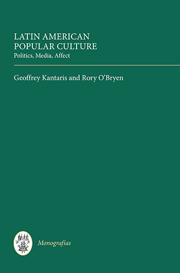Book contents
- Frontmatter
- Contents
- List of Illustrations
- Notes on Contributors
- Acknowledgements
- Introduction: The Fragile Contemporaneity of the Popular
- I Politics
- II Media
- 5 Narratives of Identity and Media Genres
- 6 Filming favelas: Space, Gender and Everyday Life in Cidade de Deus and Antônia
- 7 Colouring Pollution: ‘Cleaning’ the City and ‘Recycling’ Social Values in São Paulo Street Art
- 8 Blogging from the Margins: Grassroots Activism and Mass Media Forms in the Hiperbarrio Project
- III Affect
- Index
6 - Filming favelas: Space, Gender and Everyday Life in Cidade de Deus and Antônia
from II - Media
Published online by Cambridge University Press: 05 October 2013
- Frontmatter
- Contents
- List of Illustrations
- Notes on Contributors
- Acknowledgements
- Introduction: The Fragile Contemporaneity of the Popular
- I Politics
- II Media
- 5 Narratives of Identity and Media Genres
- 6 Filming favelas: Space, Gender and Everyday Life in Cidade de Deus and Antônia
- 7 Colouring Pollution: ‘Cleaning’ the City and ‘Recycling’ Social Values in São Paulo Street Art
- 8 Blogging from the Margins: Grassroots Activism and Mass Media Forms in the Hiperbarrio Project
- III Affect
- Index
Summary
In the last ten years there has been a surge in films about Brazilian favelas for domestic and international markets, led by Kátia Lund's and Fernando Meirelles's blockbuster Cidade de Deus (City of God, 2002). Most of those films focus on the violence generated by drug trafficking: this is most famously the case with Cidade de Deus, but it also true of José Padilha's Tropa de Elite (Elite Squad, 2007) and Tropa de Elite 2 (Elite Squad 2, 2010), which offer an implicit response to Cidade de Deus by showing the drug war from the point of view of the police; and M.V. Bill's and Celso Athayde's documentary Falcão: Meninos do Tráfico (Falcão: Traffic Boys, 2006), which also responds to Cidade de Deus by presenting a view from within the favela. Other works, such as Matt Mochary's and Jeff Zimbalist's documentary Favela Rising (2005), concentrate on youth music and social initiatives that are presented as alternatives to drug trafficking – that is, they are films that, without focusing on drug violence per se, have it as the motivation for the artistic endeavours they document. An exception to this violence-centred cinematic view of favelas is Tata Amaral's Antônia (2006), where the violence caused by the traffic of drugs and illegal weapons is simply not present. Yet the favela where the action of Antônia takes place, Vila Brasilândia on the north side of São Paulo, is, like Cidade de Deus in Rio, notorious for being a violent, drug-ridden place that has seen many prolonged shoot-outs between the PCC and the police.
- Type
- Chapter
- Information
- Latin American Popular CulturePolitics, Media, Affect, pp. 167 - 186Publisher: Boydell & BrewerPrint publication year: 2013



